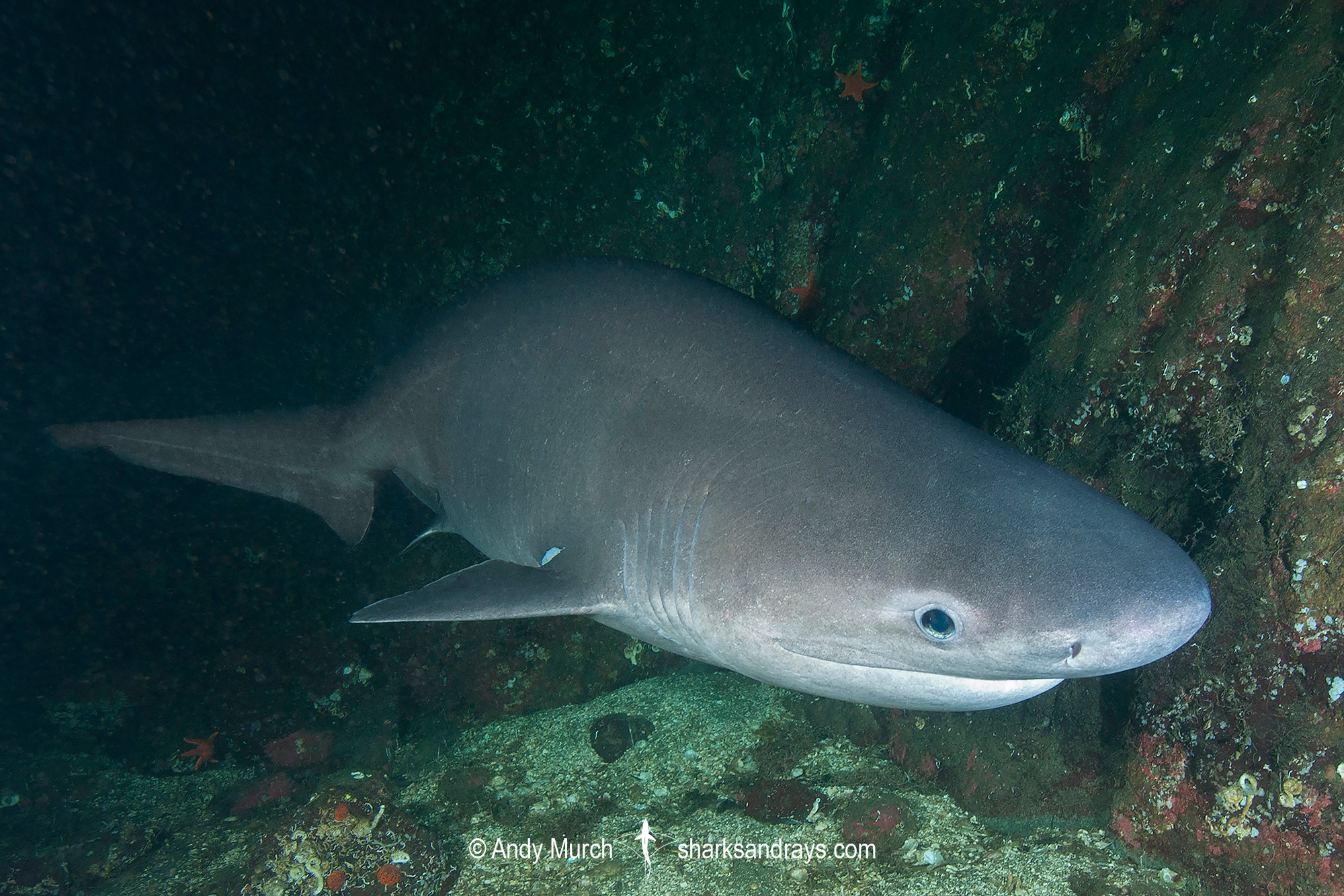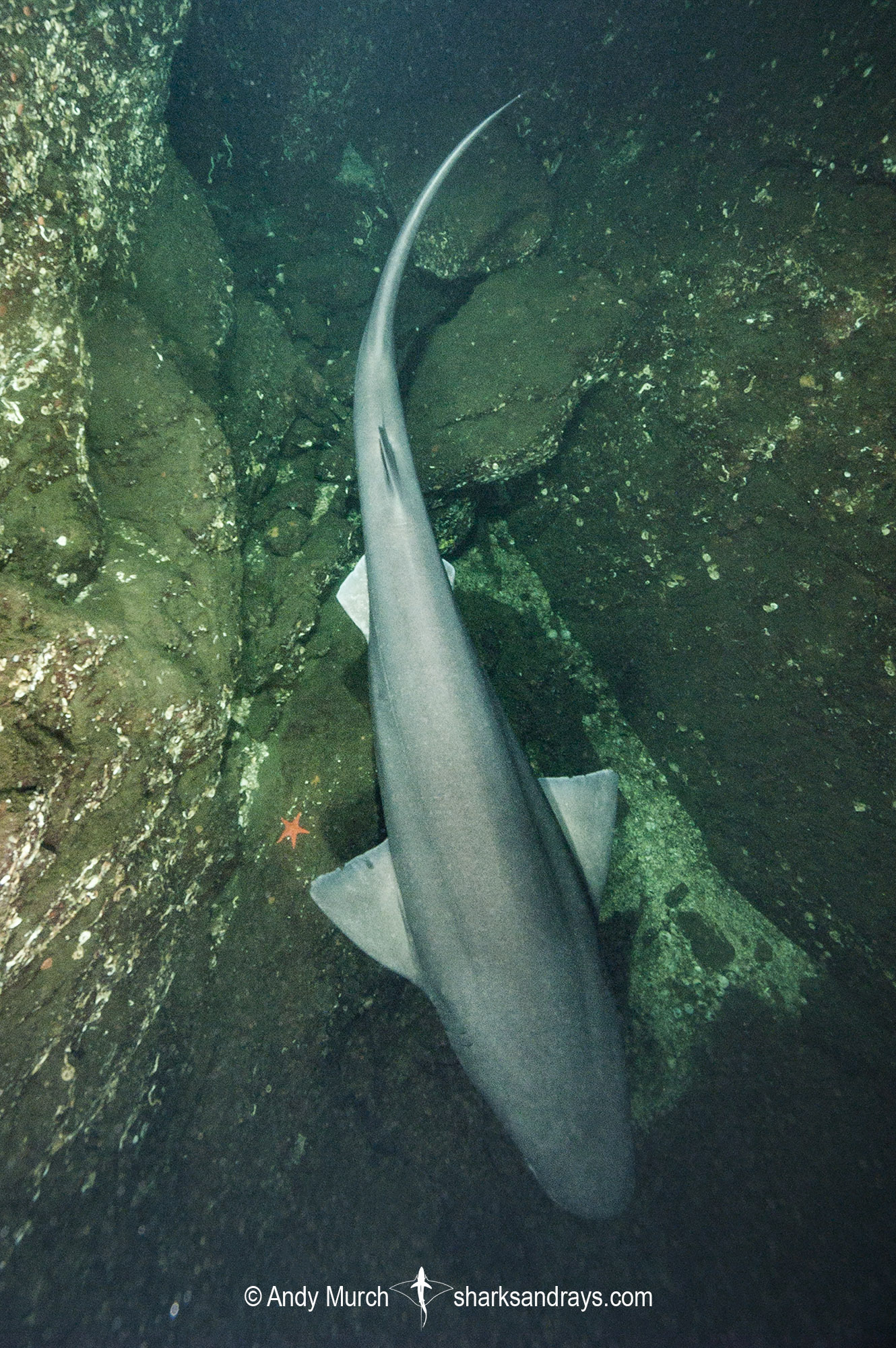Common names
Bluntnose Sixgill Shark, Sixgill Shark.
Binomial
Hexanchus griseus
Synonyms
Hexanchus corinum, Hexanchus corinus, Hexanchus griseus australis, Monopterhinus griseus, Monopterinus griseus, Notidanus griseus, Notidanus monge, Notidanus vulgaris, Squalus griseus, qualus vacca.
Identification
A large, heavy-bodied cow shark with a bluntly rounded snout. Six gill slits. Six broad, sawlike teeth on each side of lower jaw. Single dorsal fin. Dorsal origin approximately level with free rear tips of pelvic fins. Pectoral fin posterior margins not falcate. Caudal fin has an indistinct lower lobe. Upper caudal lobe weakly notched. Dorsal coloration grey or greyish-brown. Lateral line pores sometimes form a white line on flank and caudal fin. Ventral coloration pale. Occasionally, overall coloration dark brown with very little countershading. Fins either unmarked or dusky.
Size
Maximum length 482cm, possibly larger. Anecdotal accounts often mention larger animals but none have been accurately measured. Size at birth 61-74cm.

Conservation Status
NEAR THREATENED
The bluntnose sixgill shark (Hexanchus griseus) is a bycatch species in deepwater fisheries throughout much of its range. Due to its late age of maturity, it has a reduced capacity to recover from fishing pressure. Declines have been reported where fishing pressure is intense.
The global bluntnose sixgill population is estimated to have been reduced by 20–29% over the past three generations (160 years).

Habitat
Usually a deepwater species on the outer continental shelf, submarine canyons, deep ocean slopes, but the bluntnose sixgill regularly enters shallow water in the northeastern Pacific. Usually 200-1100m. Maximum depth at least 2000m. Adults found in much deeper water than juveniles.
Distribution
The bluntnose sixgill shark is probably cosmopolitan in deep water around most large land masses but its range is fragmented in catch records.
Reproduction
An aplacental viviparous species. Litter size 47-108 based on two accounts from 1900 and 1907. Gravid females are rarely caught.
Diet
The bluntnose sixgill is a capable hunter as well as a scavenger. It consumes a wide variety of bony fishes including sharks, skates, rays, chimaeras, dolphinfish, small swordfish and marlins, herring, grenadiers, antimoras (codlings), rockfishes, cod, lingcod, hake, flounders, halibut, turbot, gurnards and anglerfish. It is known to take captured fish from lines. Invertebrate prey items include squid, crabs, sea cucumbers, and shrimp. It also consumes dolphin and whale meat (almost certainly as carrion) and seals.
During submarine tours in Roatan, sixgills were fed horse meat, indicating that they are opportunistic scavengers that will consume almost anything.
Behavior
Two tagged sixgills in Bermuda stayed close to the substrate between 600-1500m while hunting(?) over a large area. Bluntnose sixgills in the Eastern Pacific enter much shallower water than their Atlantic cousins, regularly entering shallow bays on the west coast of North America. In The Sharks of North America Jose Castro postulates that there may be two distinct species.
Considering their deep ocean habitat, it is interesting to note that bluntnose sixgill sharks have a very large pineal window; an area of very thin skin and bone in the centre of the forehead (common among many deepwater sharks) that allows light to penetrate directly into the pineal organ in the brain. The window allows seven times the normal amount of light to reach the pineal organ but the purpose of this among deepwater sharks is still in question. It may work like a dinner bell, indicating to the shark when it should move into deeper or shallower water to take advantage of different prey species. Or perhaps, as in higher vertebrates, it helps to regulate the shark’s ‘sleep/dormancy patterns’ based on subtle changes in ambient light levels.
Reaction to divers
Bluntnose sixgills are often curious around divers, making fairly close passes. Likewise, they generally allow divers to approach closely before moving away. Rarely aggressive in non-baited situations but they have bumped divers and there is one confirmed non-fatal attack on a hookah diver collecting clams in Puget Sound.
CAUTION: In baited situations, bluntnose sixgill sharks become very aggressive, persistently approaching from all directions once over stimulated.
Diving logistics
The only area where bluntnose sixgill sharks are occasionally seen on scuba is at dive sites in Washington State and British Columbia. Elsewhere, they inhabit much deeper water, although they have been recorded in shallow bays as far south as San Francisco.
WASHINGTON STATE
In Washington State, sixgills make random appearances in a number of areas e.g. Commencement Bay and Elliott Bay, but for the last few years, Redondo in Des Moines has been a good spot. The majority of encounters occur during the salmon fishing season, so the sixgills may be attracted by the boats that throw fish scraps overboard while going in and out of the Redondo launch ramp. (Ed Gullekson Intel.)
VANCOUVER ISLAND
In British Columbia, sixgills have been seen at numerous locations around Vancouver Island but their appearance (and subsequent disappearance) is an enigma.
When I first moved to Vancouver Island in 2003, Hornby Island was pitched as ‘the sixgill capital of the world’. At the time this was justifiable because sightings of sixgills were commonplace there at one spot called Flora Inlet. For no reason that anyone could determine, after a few seasons, the encounters dropped off. Then, for two or three summers, we started running into sixgills at dive sites in Saanich Inlet (where I took my images) right near the City of Victoria, but again the sixgills moved on. Then I heard reports of them further up the east coast, and then on the west coast at Tahsis Inlet. I made a couple of trips there and actually managed to see one, if only for a few brief seconds before it returned to deep water. In recent years, the best encounters have been in Barkley Sound, but there have not been any sightings there since 2018.
There may be a long reproductive cycle or prey species cycle (perhaps a decade or more in length) that attracts localized populations to particular areas, that may eventually become apparent but no patterns have been established yet.
Where the next hotspot will be is anyone’s guess. Even at the best times, there is no guarantee you will see a sixgill if you travel there, but when it’s ‘on’ your chances of seeing a few during a week of diving are pretty good. Some very lucky divers have seen multiple sixgills on a single dive.
ROATAN, HONDURAS
If a cold, deep dive in the northeastern Pacific isn’t your thing, there is a deepwater submarine tour/ shark feed in Roatan (Honduras) that attracts large bluntnose sixgill sharks. As an ex-sub pilot, I can testify that shooting through a curved window made of thick acrylic is not the best way to get good photographs but it still must be quite a spectacle, watching the sixgills tear into the bait. Occasionally, the sub also encounters a rarely seen Caribbean rough shark, but they do not participate in the feed.
Similar species
Atlantic Sixgill Shark Differentiated by proportionately larger eyes, five (not six) sawlike teeth on each side of the lower jaw, and lower, longer pelvic fins. Restricted to deep water in the western Atlantic.
Bigeye Sixgill Shark Very similar to the Atlantic sixgill shark but present in the Indo-west Pacific and southern Europe.
The Shark Forum
Let’s talk about sharks




